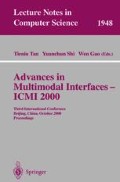ABSTRACT
This paper discusses the computational framework for enabling multimodal conversational interface agents embodied in lifelike characters within a multi-agent environment. It is generally argued that one of the problems with such interface characters today is their inability to respond believably or adequately to the context of an interaction and the surrounding environment. Affective behaviour is used to better express responses to interaction context and provide more believable visual expressive responses. We describe an operational approach to enabling the computational perception required for the automated generation of affective behaviour through inter-agent communication in multi-agent real-time environments. The research is investigating the potential of extending current agent communication languages so as they not only convey the semantic content of knowledge exchange but also they can communicate affective attitudes about the shared knowledge. Providing a necessary component of the framework required for autonomous agent development with which we may bridge the gap between current research in psychological theory and practical implementation of social multi-agent systems.
Access this chapter
Tax calculation will be finalised at checkout
Purchases are for personal use only
Preview
Unable to display preview. Download preview PDF.
REFERENCES
Arafa, Y., & Mamdani, E. Real-time Chracters with Artificial Hearts, IEEE Conf. On Systems, Man and Cybernetics, pp 456–564, 1999.
Bates, J. The Role of Emotion in Believable Agents. In Communication of the ACM (37)7:122–125, 1994.
Bower, G.H., & Cohen P.R. Emotional Influences in Memory & Thinking:Data & Theory. Clack. & Fiske Eds, Affect & Cognition, pp 291–233: Lawrence Erlbaum Association Publishers, 1982.
Conte, R. & Castelfranchi, C., Cognitive and Social Action. UCL Press Limited, UC L, 1995.
Finin, T.& Fritzson, R.; KQML: A Language & Protocol for Knowledge & Information Exchange, Proc. 19th Intl. DAI Workshop, pp 127–136,1994.
FIPA-ACL99 http://www.fipa.org/spec/fipa99spec.htm
Lang, P. The Emotion Probe: Studies of Motivation & Attention,American Psychologist 50-5:372–385 1995.
Maes, P. 1994. Agents that Reduce the Work Overload. Communications of ACM 37(7):31–40.
Maybury, M. Communicative acts for generating natural language arguments. Proc. 11th Conf. AAAI, pp 357–364, 1993.
McCrae, R. and Costa P. T. The structure of Interpersonal Traits: Wiggin’s Circumplex & the Five Factor Model. Journal of Personality & Social Psychology 56(5): 586–595, 1989.
Mc Guigan, R., Delorme, P., Grimson, J., Charlton, P., Arafa, Y. 1998. The Reuse of Multimedia Objects by Software Agents in the Kimsac System. OOIS’1998.
Ortony, A., Clore, G., & Collins A. The cognitive Structure of Emotions. Cambridge Uni. Press. 1990.
Pelachaud, C. & Poggi, E., Facial Performative in a Conversational System. In WECC’98, The First Workshop on Embodied Conversational Characters.
Picard, R.,’ 97. Affective Computing. The MIT Press.
Wooldridge, M. and Jennings, N.. Intelligent Agents: Theory & Practice. Knowledge Engineering Review 10(2):115–152. 1995.
Author information
Authors and Affiliations
Editor information
Editors and Affiliations
Rights and permissions
Copyright information
© 2000 Springer-Verlag Berlin Heidelberg
About this paper
Cite this paper
Arafa, Y., Mamdani, A. (2000). A Framework for Supporting Multimodal Conversational Characters in a Multi-agent System. In: Tan, T., Shi, Y., Gao, W. (eds) Advances in Multimodal Interfaces — ICMI 2000. ICMI 2000. Lecture Notes in Computer Science, vol 1948. Springer, Berlin, Heidelberg. https://doi.org/10.1007/3-540-40063-X_86
Download citation
DOI: https://doi.org/10.1007/3-540-40063-X_86
Published:
Publisher Name: Springer, Berlin, Heidelberg
Print ISBN: 978-3-540-41180-2
Online ISBN: 978-3-540-40063-9
eBook Packages: Springer Book Archive

